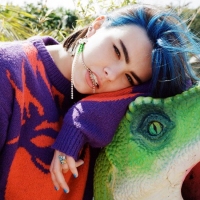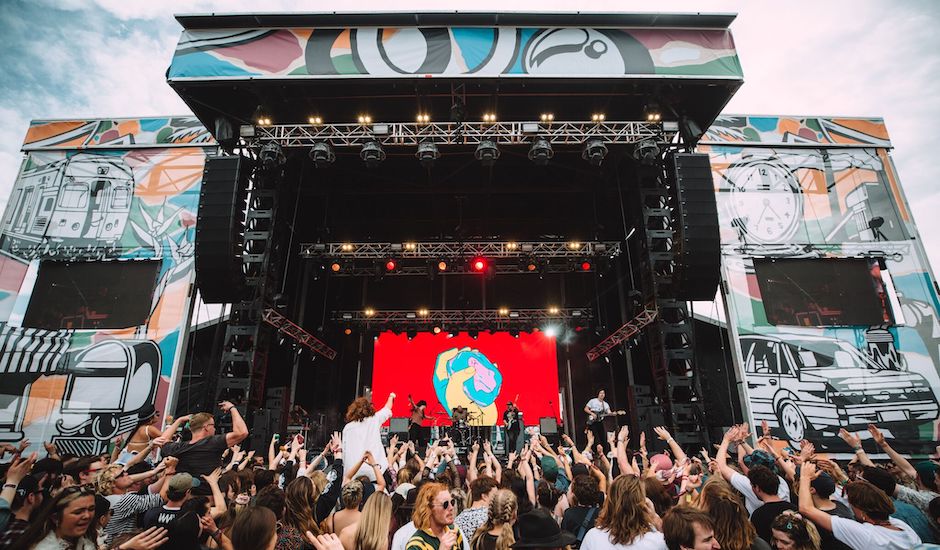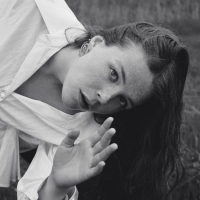 This Week's Must-Listen Singles: BENEE, Spacey Jane, Young Franco + moreAll that, plus all new singles from Billy Davis and Genes.
This Week's Must-Listen Singles: BENEE, Spacey Jane, Young Franco + moreAll that, plus all new singles from Billy Davis and Genes.

Are festivals becoming more unique, or are they blander than ever?
After assessing the uniqueness of Australian music festivals for the first time last year, we’re back to see if things have changed.
Header image of WAAX by Pat O'Hara, shot at Yours & Owls.
As every Australian festival shared their 2018/2019 lineups last year, a common question often found itself on top of the comment threads: “Why does this lineup feel like every other one to come out this year?”
Regardless of whether it was directed to broad, ‘general population’ lineups such as Falls Festival or those that occupied a specific niche, it was a comment that plagued the festival season and its many lineups, hinting at a sense of entitlement growing within Australian music fans as their options expanded alongside the country’s increasing festival market - something not felt in the country since the mid-10s Big Day Out / Soundwave / Future Music Festival crash.
Last year, to address these comments and decide whether festival lineups were actually all-too-familiar (or whether everyone complaining were a bunch of spoilt, whiney babies), we broke down the lineups of 25 Australian music events from Laneway Festival to R&B Fridays in an attempt to work out the most common acts within these lineups, and break down their corresponding uniqueness. We crosschecked their lineups with one another and tested for correlation and uniqueness, graphing them on a scale from the most unique - in other words, the festivals with the most acts exclusive to their event over the 2018/2019 festival season - to the least.
As it turns out, Mallrat and Winston Surfshirt were the two acts most commonly find amongst festival lineups, while genre-specific festivals such as Bluesfest and Good Things were Australia’s most unique billings - expected, considering blues and heavy rock acts are typically not found on broader, unspecific lineups targeted to no particular audience. On the contrary, broad-scoped festivals such as Field Day and Spilt Milk were among the country’s least talent-unique events, with those lineups sharing more acts with other festivals than any other events (Field Day, for example, had only one artist unique to their 2019 lineup).
Now, a year later, we return to an expanded spreadsheet (36 festivals) to identify whether Australian festivals are more or less unique than they were the year prior, testing if social media’s relentless pursuit of festival-specific lineups have encouraged festivals to break the boundaries and think outside the box (or, contrarily, the opposite: Are festival lineups blander than ever?).
What Australian festival lineups are the most unique in 2019/2020?

As you can see, by comparing the lineups of 36 different Australian music festivals announced throughout for 2019/2020 festival season, there’s a substantial amount of crossover between the acts hosted. As we found last year, the genre-specific niche lineups - Bluesfest, specialising in blues and nostalgic rock music; the cancelled Drip World, with hip-hop; Festival X and Pitch Festival, in commercial and underground dance music respectively - are the ones with the festival season’s most unique lineups, with 100% of Bluesfest’s lineup being exclusive to that festival for the second consecutive year. It makes sense too, as festivals catering to a broad population would see little-to-no ticket sales as a result of a Bluesfest-styled act, who occupy a very specific and targeted niche - the same goes with acts like Akon for Drip World; Nina Kraviz for Pitch Festival; Armin Van Buuren for Festival X.
On the other side of the spectrum, festivals targeting a broader audience with a less genre-specific lineup are the ones that often find themselves sharing the same artists. Regional festivals such as Festival Of The Sun and Party In The Paddock have a high crossover with other festivals - somewhat expected, considering they cater to an audience less spoilt for live music than those that run out of Sydney and Melbourne, for example - while city-specific festivals among the New Year peak period share international acts to reduce costs, explaining the small uniqueness percentage in events like Wildlands, Field Day, Beyond The Valley and Origin Fields.
Take Tyler, The Creator for example. Infamously banned from Australia once upon a time, the cost of securing Tyler - one of the world’s revolutionary names in 2019 rap music - would hit stratospheric levels if Origin Fields, Wildlands, Field Day and Beyond The Valley were to book him as a festival exclusive (to the point where he would probably not tour Australia due to costs). So, each of the state-specific festivals hosts him to share costs - exclusive to Origin in West Australia; to Wildlands in Queensland; to Field Day in New South Wales; to Beyond The Valley in Victoria. This occurs for a number of acts within these festivals - Skepta, RL Grime, RUFUS DU SOL and Ella Mai included - so while it seems that these festivals may not be unique to the country, they are to the state.
Otherwise, the average Australian festival lineup has a billing 54% unique to them - pretty steady compared to last year’s figure - and several of Australia’s most notorious tastemaker festivals have adjusting individual figures as well. For their 2019 event, for example, Laneway Festival’s lineup was approximately 65% unique to them, while for 2020, their lineup is only 52% unique to them. Elsewhere, the lineups for Listen Out (~60% unique in 2018, 79% in 2019) and Splendour In The Grass (~50% unique in 2018, 63% in 2019) have become more unique this year, while others including Falls Festival and FOMO keep a consistent lineup uniqueness percentage when compared to their last events.
What artists are most common to Australian festival lineups in 2019/2020?

One of the other things we identified with last year’s lineup uniqueness scale was deciphering exactly which acts were shared across the various festivals. Last year, we found that Mallrat and Winston Surfshirt were the two most common acts found on Australian lineup, followed by SAFIA, Skegss, Nyxen, Carmouflage Rose, Vera Blue, Cub Sport, The Jungle Giants, Sampa The Great and Rolling Blackouts Coastal Fever.
For the second consecutive year, Mallrat is the most common festival artist for the 2019/2020 commercial festival period, appearing on nine of the 36 lineups crosschecked (that’s 25% of all the festivals we selected). It’s a sign of her increasing dominance within the Australian music world and her position as a brilliant live artist that translates into high ticket sales, felt as she strived from her 2018 EP In The Sky to last September’s Driving Music - her Australian and global popularity increasing with her latest collection of tracks.
Dom Dolla, Golden Features, Lastlings and Hatchie are the next most popular festival acts scattered across Australian lineups (they feature on six lineups each), followed by Confidence Man, The Chats, Lime Cordiale, Trophy Eyes, Ninajirachi and WAAX, who all feature on five Australian festival lineups across 2019/2020.
By compiling the most common musicians at Australian festivals, it becomes clear that our country’s music events are continuing to invest in local talent - there are only seven international acts on this year’s most-common players, the same as last year - suggesting that festivals no longer need to draw heavyweight international acts to push tickets. There’s also a smaller presence of female, trans and non-binary-including acts within the country’s most common festival acts - 33% vs 50% last year - which may suggest that this year’s festivals are more male-dominated than last year’s (which we’re going to explore more thoroughly in another feature incoming), but may also suggest that festivals are working with a larger pool of female, trans and non-binary-including acts, no longer diving into the same few to balance out their lineups - we’ll see.
Do you want to see more from our festivals, or are you happy with the lineups we have in place? Let us know.
 This Week's Must-Listen Singles: BENEE, Spacey Jane, Young Franco + moreAll that, plus all new singles from Billy Davis and Genes.
This Week's Must-Listen Singles: BENEE, Spacey Jane, Young Franco + moreAll that, plus all new singles from Billy Davis and Genes.
 This Week's Must-Listen Singles: Maggie Rogers, Tkay Maidza, KUČKA + morePlus, an all-new single from Baker Boy and JessB, and Tyde Levi's long-awaited return.
This Week's Must-Listen Singles: Maggie Rogers, Tkay Maidza, KUČKA + morePlus, an all-new single from Baker Boy and JessB, and Tyde Levi's long-awaited return.